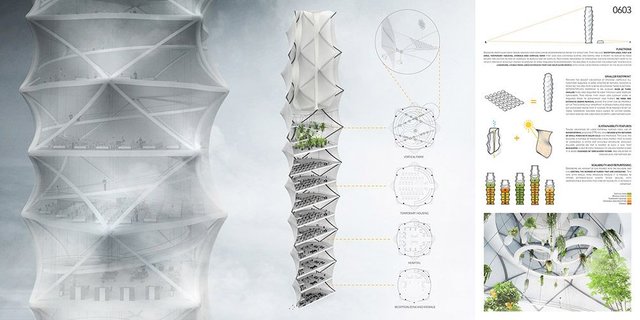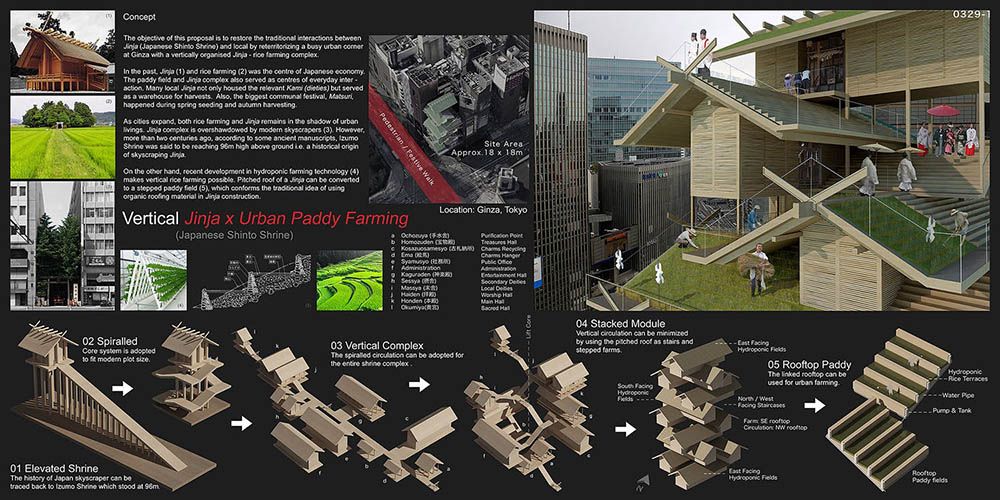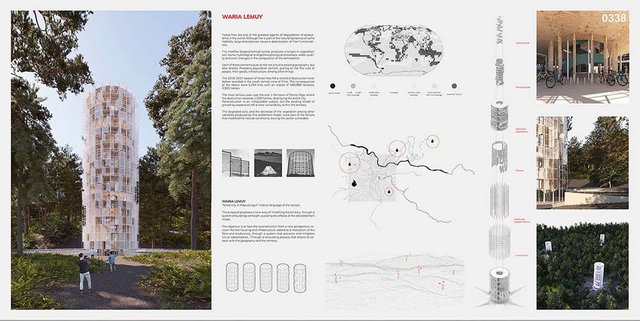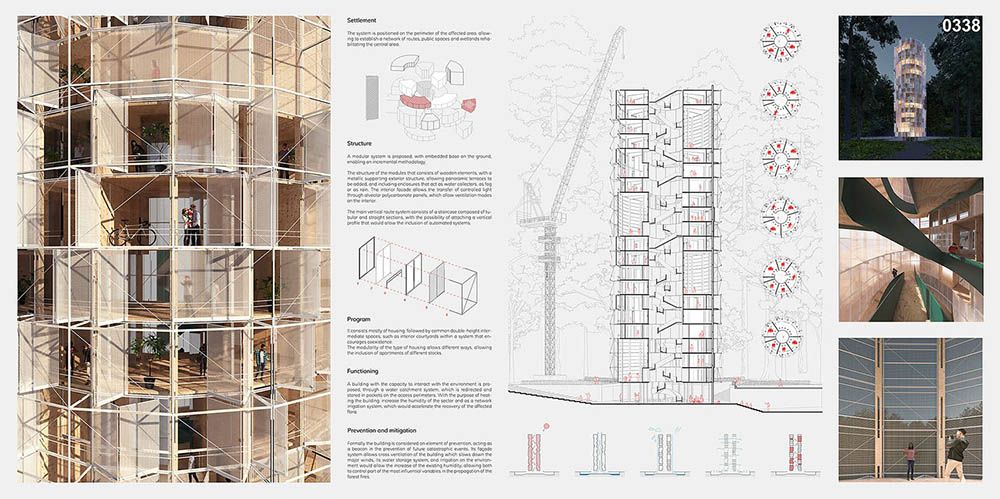Winners eVolo 2018 Skyscraper Competition
eVolo Magazine is pleased to announce the winners of the 2018 Skyscraper Competition. The Jury selected 3 winners and 27 honorable mentions from 526 projects received. The annual award established in 2006 recognizes visionary ideas- projects that through the novel novel use of technology, materials, programs, aesthetics, and spatial organizations, challenge the way we understand vertical architecture and its relationship with the natural and built environments.
The FIRST PLACE was awarded to Skyshelter.zip designed by Damian Granosik, Jakub Kulisa, and Piotr Pańczyk from Poland. The project is a foldable skyscraper inspired by origami that could be easily transported and deployed in disaster zones.
Jinja: Shinto Shrine Skyscraper designed by Tony Leung from Hong Kong received the SECOND PLACE. The project aims to restore the traditional interactions between a Shinto Shrine and the local people- an urban building for rice farming, spiritual meditation, and community development.
The recipient of the THIRD PLACE is Claudio C. Araya Arias from Chile for the project Waria Lemuy: Fire Prevention Skyscraper. This proposal envisions a new prototype for vertical housing in areas damaged by wild fires in Chile. The project makes use of passive systems to mitigate wind and disperse water to prevent new fires.
The honorable mentions include Sandscrapers that prevent desertification, floating skyscrapers that transform ocean water into fresh water, towers that collect fog in arid regions, 3-D printed buildings, and volcano skyscrapers among other visionary proposals.
1st prize
Damian Granosik, Jakub Kulisa, and Piotr Pańczyk
/ Poland /


More and more natural disasters happen annually across the world. When dealing with forces so powerful, standard means of crisis-management often prove to be inefficient. Whether certain region is struck by earthquake, flood or hurricane – help needs to arrive quickly. This is often easier to be said than done, as damages to transportation infrastructure or remote localization can make it extremely difficult. The Skyshelter.zip tries to address these issues by proposing structure that while offering large floor surface is compact, easy to transport anywhere and can be deployed with minimum amount of time and manpower requirements. It is meant to serve as multi-purpose hub for any relief operation.
EASY TRANSPORTATION
The Skyshelter.zip is extremely easy to move due to its unique qualities. The entire structure is foldable in a manner that resembles origami or accordion. This means it can be neatly packaged into single relatively small box with minimum height and base dimensions reduced to building’s footprint. Then such a package can be moved anywhere with help of helicopters commonly used by rescue teams and military in the event of a natural disasters. Because elements do not have to be transported in batches by trucks, it is easier and faster to reach zones cut off from the transportation network.
SMALLER FOOTPRINT
Perhaps the biggest advantage of stacking vertically all functions required in zone affected by natural disaster is reducing the area that is being occupied by them. Skyshelter.zip’s footprint is on average over 30 times smaller than area required to host typically used tents or containers. This means that much less cleanup work is required prior to setting up the camp. This is especially important in densely populated areas but elsewhere means that it is going to be possible to set up those temporary shelters closer to victims original homes.
INSTANT DEPLOYMENT
Just as easily as it can be transported, the Skyshelter.zip can be effortlessly and instantly deployed even on unstable soil. Little to none groundwork is required as after anchoring basic supports to the ground the structure unfolds thanks to large load-bearing helium balloon placed within (thus protected from external forces). This process is also easily reversible. Light-weight 3D-printed slabs are attached directly to balloon in succeeding manner and pulled upwards by its load-bearing force and structural steel wires that once strained are capable of resisting horizontal wind forces. In turn, internal and external walls are in fact pieces of fabric attached to slabs that unfold as the structure get deployed.
SCALABILITY AND REPURPOSING
Depending on amount of gas poured into the balloon, one can control the number of floors that are unfolding. This way, with single, mass produced module it is possible to attend different-scale, unpredictable events.
FUNCTIONS
Based on particular cases’ needs various functions can be accommodated inside, including reception area, first aid area, temporary housing, storage and vertical farm that uses soil gathered during anchoring. Additional advantage of producing vertical emergency camp is its height, partially achieved thanks to the size of the balloon. It allows for the structure to serve as a landmark, visible from large distances helping guide people affected by catastrophe straight to the relief center.
SUSTAINABILITY FEATURES
Taking advantage of large external surface area, use of nanomaterial based on ETFE foil and infused with network of small perovskite solar cells was proposed. This way, the building is capable of producing clean energy especially needed in case of emergency. Similarly, balloon located on top is shaped in such a way, that rainwater is able to flow through its hollow center where it is being cleansed by specialized filters and collected for further use.
2nd prize
Tony Leung
/ Hong Kong /

The objective of this proposal is to restore the traditional interactions between Jinja (Japanese Shinto Shrine) and local people by reterritorizing a busy urban corner in Ginza, Tokyo with a vertically organized Jinja cum rice-farming complex.
In the past, Jinja and rice farming were the center of Japanese economy.
The paddy field and Jinja complex also served as centers of everyday interaction. Many local Jinja not only housed the relevant Kami (deities) but also served as a warehouse for harvests. Also, the biggest communal festival, Matsuri, happened during spring seeding and autumn harvesting.
As cities expand, both rice farming and Jinja remains in the shadow of urban livings. Jinja complex is overshadowed by modern skyscrapers. However, more than two centuries ago, according to some ancient manuscripts, Izumo Shrine was said to be reaching 96m high above ground i.e. a historical origin of skyscraping Jinja (…)
3rd prize
Claudio C. Araya Arias
/ Chile /


Forest fires are one of the greatest agents of degradation of ecosystems in the world. Although fire is part of the natural dynamics of some habitats, large disturbances cause a deterioration of their functionalities. Fire modifies biogeochemical cycles, produces changes in vegetation, soil, fauna, hydrological and geomorphological processes, water quality and even changes in the composition of the atmosphere. Each of these elements puts at risk not only the existing geography, but also directly threatens population centers, putting at risk the lives of people, their goods, infrastructure, among other things.
The 2016-2017 season of forest fires left a record of destruction never before recorded in the south-central zone of Chile. The consequences of the above were 5,244 fires with an impact of 569,989 hectares, 2,500 homes. The most serious case was the one in the town of Santa Olga, where the destruction exceeds 1,000 homes, destroying the entire city. Reconstruction is an indisputable subject, but the existing model of growth by expansion left a clear vulnerability within the territory.
The degraded soils, and the decrease of the vegetation among other variables produced by this settlement model, were part of the factors that modified the natural conditions, leaving the sector vulnerable (…)
http://competitions.archi/competition/results-winners-evolo-2018-skyscraper-competition/